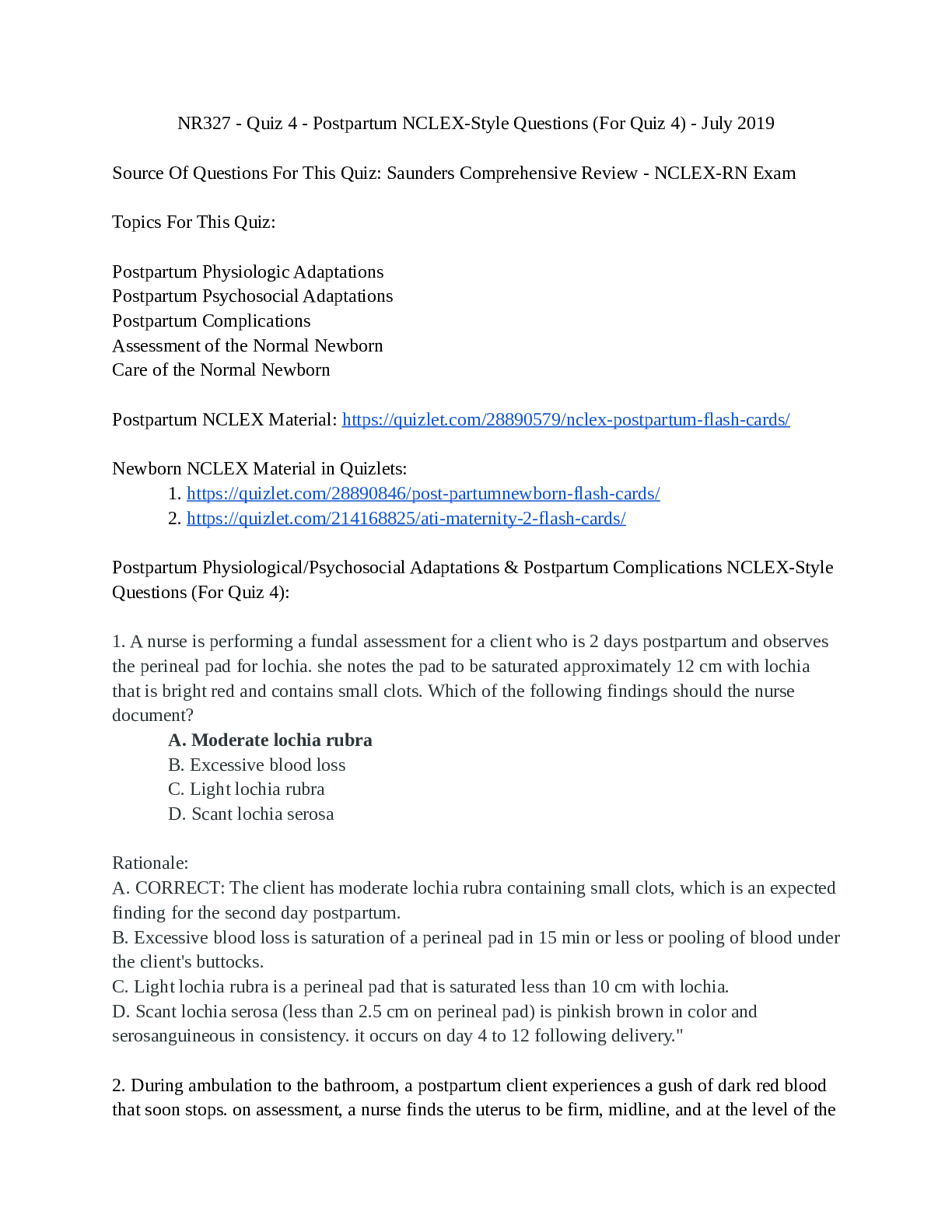*NURSING > TEST BANKS > NR327 - Quiz 4 - Postpartum NCLEX-Style Questions (For Quiz 4) - July 2019 (All)
NR327 - Quiz 4 - Postpartum NCLEX-Style Questions (For Quiz 4) - July 2019
Document Content and Description Below
NR327 - Quiz 4 - Postpartum NCLEX-Style Questions (For Quiz 4) - July 2019 Source Of Questions For This Quiz: Saunders Comprehensive Review - NCLEX-RN Exam Topics For This Quiz: Postpartum Physiologi... c Adaptations Postpartum Psychosocial Adaptations Postpartum Complications Assessment of the Normal Newborn Care of the Normal Newborn Newborn NCLEX Material in Quizlets: Postpartum Physiological/Psychosocial Adaptations & Postpartum Complications NCLEX-Style Questions (For Quiz 4): 1. A nurse is performing a fundal assessment for a client who is 2 days postpartum and observes the perineal pad for lochia. she notes the pad to be saturated approximately 12 cm with lochia that is bright red and contains small clots. Which of the following findings should the nurse document? 2. During ambulation to the bathroom, a postpartum client experiences a gush of dark red blood that soon stops. on assessment, a nurse finds the uterus to be firm, midline, and at the level of the umbilicus. Which of the following findings should the nurse interpret this data as being? 3. A nurse is completing postpartum discharge teaching to a client who had no immunity to varicella and was given varicella vaccine. Which of the following statements by the client indicates understanding of the teaching? 4. a nurse is assessing a postpartum client for fundal height, location, and consistency. the fundus is noted to be displaced laterally to the right, and there is uterine atony. the nurse should identify which of the following conditions as the cause of the uterine atony? 5. a nurse is caring for a client who is 1 hr postpartum following a vaginal birth and experiencing uncontrollable shaking. the nurse should understand that the shaking is due to which of the following factors? (select all that apply.) 6. a nurse concludes that the father of an infant is not showing positive signs of parent-infant bonding. He appears very anxious and nervous when the infant's mother asks him to bring her the infant. Which of the following actions should the nurse use to promote father-infant bonding? 7. a client in the early postpartum period is very excited and talkative. She is repeatedly telling the nurse every detail of her labor and birth. Because the client will not stop talking, the nurse is having difficulty completing the postpartum assessments. Which of the following action should the nurse take 8. A nurse is caring for a client who is 1 day postpartum. The nurse is assessing for maternal adaptation and mother-infant bonding. Which of the following behaviors by the client indicates a need for the nurse to intervene? (Select all that apply.) 9. A nurse is caring for a client who is 2 days postpartum. The client states, "My 4-year old son was toilet trained and now he is frequently wetting himself." Which of the following statements should the nurse provide to the client? 10. A nurse in the delivery room is planning to promote maternal-infant bonding for a client who just delivered. Which of the following is the priority action by the nurse? 11. a nurse is conducting a home visit for a client who is 1 week postpartum and breastfeeding. the client reports breast engorgement. Which of the following recommendations should the nurse make? 12. a nurse is providing discharge instructions for a client. at 4 weeks postpartum, the client should contact her provider for which of the following client findings? 13. a nurse is providing discharge teaching for a nonlactating client. Which of the following instructions should the nurse include in the teaching? 14. a nurse is providing discharge instructions to a postpartum client following a cesarean birth. the client reports leaking urine every time she sneezes or coughs. Which of the following interventions should the nurse suggest? 15. a nurse is providing care to four clients on the postpartum unit. Which of the following clients is at greatest risk for developing a postpartum infection? 16. a nurse is caring for a client who is postpartum. the nurse should identify which of the following findings as an early indicator of hypovolemia caused by hemorrhage 17. a nurse educator on the postpartum unit is reviewing risk factors for postpartum hemorrhage with a group of nurses. Which of the following factors should the nurse include in the teaching? (select all that apply.) 18. a nurse on the postpartum unit is performing a physical assessment of a client who is being admitted with a suspected deep-vein thrombosis (DVt). Which of the following clinical findings should the nurse expect? (select all that apply.) 19. a nurse on the postpartum unit is planning care for a client who has thrombophlebitis. Which of the following nursing interventions should the nurse include in the plan of care? 20. a nurse is caring for a client who has disseminated intravascular coagulation (DiC). Which of the following antepartum complications should the nurse understand is a risk factor for this condition? 21. a nurse on the postpartum unit is caring for four clients. Which of the following clients should the nurse recognize as the greatest risk for development of a postpartum infection? 22. a nurse is teaching a client who is breastfeeding and has mastitis. Which of the following responses should the nurse make? 23. a nurse is reviewing discharge teaching with a client who has a urinary tract infection. Which of the following statements by the client indicates understanding of the teaching? (select all that apply.) ................................................................continued................................................................................ [Show More]
Last updated: 2 years ago
Preview 1 out of 11 pages

Buy this document to get the full access instantly
Instant Download Access after purchase
Buy NowInstant download
We Accept:

Reviews( 0 )
$14.00
Can't find what you want? Try our AI powered Search
Document information
Connected school, study & course
About the document
Uploaded On
Jun 03, 2021
Number of pages
11
Written in
Additional information
This document has been written for:
Uploaded
Jun 03, 2021
Downloads
0
Views
99





.png)

.png)
 (1).png)




